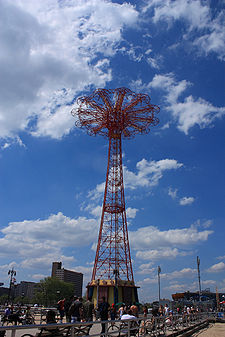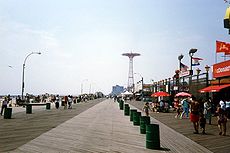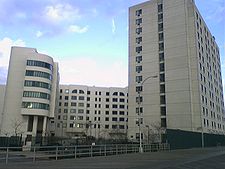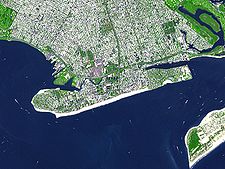- Coney Island Development
-
Contents
Early development
Development on Coney Island has always been controversial. When the first structures were built around the 1840s, there was an outcry to prevent any development on the island and preserve it as a natural park. Starting in the early 1900s, the City of New York made efforts to condemn all buildings and piers built south of Surf Avenue. It was an effort to reclaim the beach which by then had almost completely been built over with bath houses, clam bars, amusements, and other structures. The local amusement community opposed the city. Eventually a settlement was reached where the beach did not begin until 1,000 feet (300 m) south of Surf Avenue, the territory marked by a city-owned boardwalk, while the city would demolish any structures that had been built over public streets, to reclaim beach access.
Robert Moses
Since the 1920s, all property north of the boardwalk and south of Surf Avenue was zoned for amusement and recreational use only, with some large lots of property north of Surf also zoned for amusements only.
In 1944, Luna Park was damaged by fire, and sold to a company who announced they were going to tear down what was left of Luna Park and build apartments. Robert Moses had the land rezoned for residential use with the proviso that the apartment complex include low-income housing.
In 1949, Moses moved the boardwalk back from the beach several yards, demolishing many structures, including the city's municipal bath house. He would later demolish several blocks of amusements to clear land for both the New York Aquarium and the Abe Stark ice skating rink. Critics complained that Moses took three times more land than each structure needed, surrounding each with vacant lots that were of no use to the city.
In 1953, Moses had the entire island rezoned for residential use only and announced plans to demolish the amusements to make room for public housing. After many public complaints, the Estimate Board reinstated the area between West 22 Streets and The Cyclone as amusement only and threw in 100 feet (30 m) of property north of Surf Av. between these streets. It has since then been protected for amusement use only, which has led to many public land battles.
Fred Trump
 The Parachute jump towers over the Coney Island boardwalk
The Parachute jump towers over the Coney Island boardwalk
In 1964, Coney Island's last remaining large theme park, Steeplechase Park, closed. The rides were auctioned off, and the property was sold to developer Fred Trump, the father of Donald Trump. Trump, convinced that the amusement area would die off once the large theme parks were gone, wanted to build luxury apartments on the old Steeplechase property. He spent ten years battling in court to get the property rezoned. At one point Trump organized a funeral for amusement parks in Coney Island. Trump invited the press to the funeral where bikini-clad girls first handed out hot dogs, then handed out stones which Fred invited all to cast through the stained-glass windows of the pavilion. Then, pronouncing the amusement park dead, he had the pavilion bulldozed. After a decade of court battles, Trump exhausted all his legal options and the property was still zoned only for amusements. He eventually leased the property to Norman Kaufman, who ran a small collection of fairground amusements on a corner of the site calling his amusement park "Steeplechase Park".
But between the loss of both Luna Park and the original Steeplechase Park, as well as an urban-renewal plan that took place in the surrounding neighborhood where middle class houses were replaced with housing projects, fewer people visited Coney Island. With attendance dropping, many amusement owners abandoned their properties. In the late 1970s, the city came up with a plan to revitalize Coney Island by bringing in gambling casinos, as had been done in Atlantic City. The city's plans backfired when the prospect of selling property to rich casino owners created a land boom where property was bought up and the rides cleared in preparation of reselling to developers. Gambling was never legalized for Coney, and the area ended up with vacant lots.
1970s
In 1979 the city purchased Steeplechase Park from Fred Trump and proceeded to evict Norman Kaufman's amusements. By this time, Kaufman had expanded his park and had plans to eventually rebuild the historic Steeplechase Park. He had even bought back the original Steeplechase horse ride with plans to install it the following season. But the city decided it did not want to wait decades for Steeplechase park to be rebuilt and believed it could attract a developer to build a large combination theme park and casino on the site. The property remained vacant for another five years.
Horace Bullard
In the mid 1980s, businessman Horace Bullard approached the city to allow him to rebuild Steeplechase Park. He had already bought several acres of property just East of the Steeplechase Park site, including the property with a large coaster called The Thunderbolt and property west of Abe Stark rink. His plans called for the combination of his property as well as the Steeplechase property and the unused property on the Abe Stark site as a multimillion-dollar theme park based on the original. The city agreed and in 1986 the state legislature approved the project. However, several bureaucrats held up the project for another two years while the NYC Planning Commission compiled an environmental impact report. In 1987, state senator Thomas Bartosiewics attempted to block Bullard from building on the Steeplechase site. Bartosiewics was part of a group called The Brooklyn Sports Foundation which had promised another theme park developer, Sportsplex, the right to build on the site. Construction was held up for another four years as Bullard and Sportsplex fought over the site.
Keyspan Stadium
In 1994, Rudy Giuliani took office as mayor of New York and killed the Bullard deal. Giuliani claimed he wanted to build Sportsplex, provided it include a stadium for a minor-league team owned by the Mets. But when Giuliani ordered the stadium to be built first, Sportsplex accused the city of planning to build a parking lot on the property earmarked for the Sportsplex construction. Giuliani publicly denied this and promised Sportsplex could begin construction the moment the stadium was finished. As soon as the stadium was completed, Giuliani killed the Sportsplex deal and had the parking lot built. The Mets decided the minor league team would be called The Brooklyn Cyclones and sold the naming rights to the stadium to Keyspan Energy. Executives from Keyspan complained that the stadium's line of view from the rest of Coney Island amusement area was blocked by the now derelict Thunderbolt coaster and considered not going through with the deal. Bullard, now no longer rebuilding Steeplechase Park, had wanted to restore the coaster as part of a scaled-down amusement park. The following month, Giuliani ordered an early-morning raid on the Thunderbolt, claiming that the coaster was in immediate danger of collapse and ordering it bulldozed. The structure that was supposed to be near collapse took many days to be torn down. No connection between the Mets organization and the demolition has ever been proven, but many accuse Giuliani of tearing it down at the Mets' request.
Thor Equities
In 2003, Mayor Michael Bloomberg took an interest in revitalizing Coney Island as a possible site for the 2012 Olympics. A plan was developed by the Astella Development Corporation. When the city lost the bid for the Olympics, revitalization plans were rolled over to The Coney Island Development Corporation (CIDC), which came up with a plan to restore the resort. Many amusement owners worried that because one of the report's goals to develop the area as a year-round destination, they could be forced out as their businesses are only seasonal and did not meet the CIDC's year-round goal. The CIDC also suggested that property north of Surf Avenue and west of Abe Stark should be rezoned for other uses including residential to lure developers into the area. Shortly before the CIDC's plans were publicly released, a development company, Thor Equities, purchased all of Bullard's western property, worth $2.2 million, for $16 million. Now owning property that was earmarked for rezoning to residential, they sold the property to Taconic for a $72 million profit.
Thor then went about using much of the $72 million to purchase property well over market value lining Stillwell Avenue and offered to buy out every piece of property inside the traditional amusement area. Quickly, rumors started that Thor was interested in building a retail mall in the heart of the amusement area. In September 2005, Thor's founder, Joe Sitt, went public with his new plans, which he claimed was going to be a large Bellagio-style hotel resort surrounded by rides and amusements. He also claimed that the interior of the resort would have an indoor mall that would allow local amusement owners to relocate their rides and operate them indoors year round and made promises that he had no intention of driving out any local amusement owners and wanted them all to be part of his new resort. Sitt released renderings of a hotel that would take up the entire amusement area from the Aquarium to beyond Keyspan Park and would most likely need to involve the demolition of The Wonder Wheel, Cyclone, and Nathan's original hot dog stand, as well as the new Keyspan Park. At the same time, the borough of Brooklyn was involved with two other major development projects: the Atlantic Yards project, which involved eminent domain; and the Brooklyn Bridge Park project, which involved the demolition of a building with landmark status. Many feared that the city had already backed Thor's plans and that the entire amusement district would be demolished to make way for the new multimillion dollar resort.
In June 2006 Ehrenkrantz Eckstut & Kuhn (EEK), an architectural design firm working for Thor, released detailed renderings of Thor's planned resort area showing luxury high rise condo towers in place of the hotel with retail on the ground floor. Since the area has both zoning restrictions only allowing amusements and no buildings taller than 260 feet (79 m). Thor initially denied any inclusion of condo towers in its plans and Eek quickly removed the renderings from its site, but not before blogs everywhere published copies of the renderings. Thor quickly released renderings of rides, including a steel coaster that would run above the boardwalk, a two tiered carousel, and a fountain at the foot of Stillwell Av. that would project images of whales and mermaids. Thor admitted that condos would be part of its resort and said that the resort was not economically feasible without the addition of condos. At a public meeting Thor representatives continued to downplay the condos by claiming that the company only wanted to build hundreds of condo units, not thousands. While Thor initially said it only wanted to build 575 condos the number crept up to 975. Late in 2006 Thor announced that it had just purchased Coney Island's last remaining amusement park, Astroland, and would be closing it after the 2007 season. Immediately Thor announced plans to build a Nickelodeon-themed hotel on the site.
In January 2007 Thor released renderings for a new amusement park to be built on the Astroland site called Coney Island Park.[1]
Critics pointed out that even though Thor claimed its project would expand the amusement area, the company had already evicted several acres of amusements from the property it bought and planned to evict the rest of the amusements on the property after the 2007 season, as well as close Astroland.
Meanwhile, the city brought up its own concerns about Thor's plans based on history with the developer. In 2001 Thor purchased the Albee Square Mall for $25 million claiming it wanted to revitalize it. Thor said it wanted to give the mall a Vegas-style makeover and bring in more name brand retail while maintaining the original vendors occupying the mall. The city complied and rezoned the property to permit the building of an office tower above the mall. Soon after, Thor sold the property to Arcadia Reality Trust for $125 million. Arcadia plans to demolish the mall and build the tower only with a possible box store on the ground level. City officials questioned Thor's motives for wanting the zoning changes inside the amusement zone and feared that once Thor gets those changes, it will flip the property to the highest bidder who will have no obligation to build any amusements.
In the winter of 2007 Thor meant business and began to evict businesses from the buildings it owned along the boardwalk. But when one of the business owners went to the press with a statement that Thor was requiring its tenants to sign a confidentiality clause that lasted three years and prevented them from publicly commenting on Thor redeveloping the area, Thor quickly reinstated their leases.
Astroland owner Carol Hill Albert, whose husband's family had owned the park since 1962, sold the site to developer Thor Equities in November 2006 for an undisclosed amount. Thor proposed a $1.5 billion renovation and expansion of the Coney Island amusement area to include hotels, shopping, movies, an indoor water park and the city's first new roller coaster since the Cyclone. The Municipal Art Society launched the initiative ImagineConey[2], in early 2007, as discussion of a rezoning plan that highly favored housing and hotels began circulating from the Department of City Planning[3]. MAS held several public workshops, a call for ideas, and a charrette to garner attention to the issue. City Planning certified the rezoning plan in January 2009 to negative responses from all amusement advocates and Coney Island enthusiasts. The plan is currently working through the ULURP process.[4] Thor Equities has said it hopes to complete the project by 2011.[5] Thor Equities plan to demolish most of the iconic, early 20th century buildings along Surf Avenue. In their place, Sitt plans to build cheap, one-story retail, and his recently released rendering clearly shows Burger King and Taco Bell-like buildings.[6] The Aquarium is also planning a renovation.[7] In June 2009, the city's planning commission unanimously approved the construction of 4,500 units of housing and 900 affordable units and vowed to "preserve, in perpetuity, the open amusement area rides that everyone knows and loves," while protesters argued that "20 percent affordable-housing component is unreasonably low." [8]
References
- ^ [1] 1.5 Billion Development Plan For Coney Island Publication: The New York Sun Date: 13 November 2006
- ^ http://imagineconey.com
- ^ http://www.nyc.gov/html/dcp/home.html
- ^ http://www.nyc.gov/html/dcp/html/luproc/ulpro.shtml
- ^ See Bloomberg News, November 29, 2006.
- ^ http://www.allmediany.com/scroll_article.php?scr_id=14
- ^ "Plans Coming Together For Coney Island Amusement Park Expansion", NY1, November 14, 2006
- ^ [2] Planning Commission Approves Unloved Coney Plan: The Village Voice: 6/17/09
Categories:
Wikimedia Foundation. 2010.



